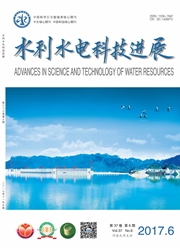

 中文摘要:
中文摘要:
为探讨珠江河口磨刀门水道盐水入侵规律,采用同步实测的方法对磨刀门水道上至竹银下至口门近半月的水文和盐度进行了测量。结果表明,磨刀门水道盐度总体呈现向上游递减的趋势;口门位置表、底层平均盐度在不同潮型和涨落潮下相差较大,变化范围在1.7%~2.4%之间,尤以枯季分层明显,通常落潮期表、底层盐度差异比涨潮期大;上游竹银位置不同潮型下的表、底层盐度相差较小,平均涨落潮盐度都在0.1%以内;从磨刀门水道沿程表、底层盐度相差比例统计来看,大、中、小潮期间底层平均盐度比表层分别大43.1%、53.4%和77.4%,且流速和盐度的垂向分布存在较好的对应关系,因此小潮期间,更容易出现异重流现象。近口门河段盐度随水深减小而直线递减,上游河段则呈指数递减规律;大潮时,两种分布规律的分界位置距口门23 km左右,中潮和小潮时距口门17 km左右。
 英文摘要:
英文摘要:
For obtaining the rules of seawater intrusion in the Modaomen Waterway of the Pearl River Estuary, almost half a month, the hydrology and salinity were synchronously measured at the river section from Zhuyin down to Koumen. The results show that the salinity in the Modaomen Waterway generally presents a decreasing trend from downstream to upstream. In Koumen, the average salinity in surface water and at bottom, under different tides and flood-ebb fluctuation, has a large difference with a variation range between 1.7% and 2.4%, whose layering is clearer in dry seasons. Additionally, the difference in ebb period is typically larger than tide rising period. However, in Zhuyin, the salinity in surface water and at bottom, under different tides, has a small difference, with the average salinity lower than 0.1% under flood-ebb fluctuation. From the perspective of ratio statistics of differences between surface and bottom salinities along the Modaomen Waterway, the average salinity at bottom is 43.1%, 53.4%, and 77.4% higher than that in surface water in spring, middle, and neap tides, respectively. Furthermore, there exits better corresponding relations between velocities and salinities along water depth, so it is easier for the emergence of gravity flow during the neap tide. Closely to Koumen, salinity linearly decreases with the decrease of water depth;in upstream, salinity demonstrates the index declining rule. In addition, termination points of the two distribution rules are respectively about 23 km under spring tide and 17 km under middle and neap tides far from Koumen.
 同期刊论文项目
同期刊论文项目
 同项目期刊论文
同项目期刊论文
 期刊信息
期刊信息
